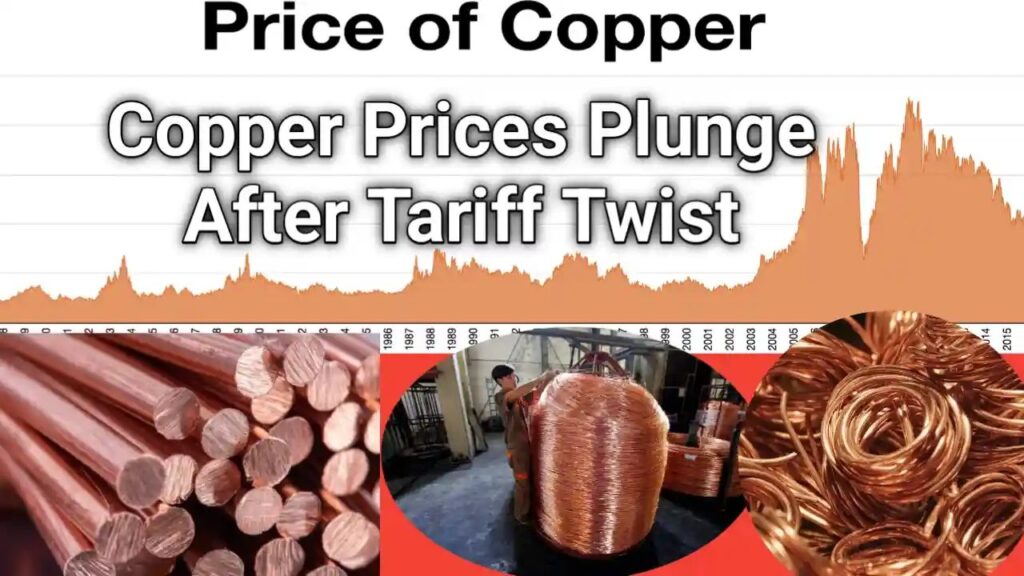
Copper Prices in 2025: A Deep Dive into the Latest Crash and What Lies Ahead
Copper prices are always in motion, shaped by a delicate balance of global economics, supply-demand fluctuations, and political developments. As of July 31, 2025, copper prices have experienced their sharpest single-day fall in recent history—raising questions about what’s next for this crucial industrial metal.
📉 Current Copper Price Update (as of July 31, 2025)
- Copper futures plunged nearly 20%, dropping to $4.55 per pound on July 30, marking the largest intra-day fall ever recorded.
- The price has now stabilized slightly at around $4.42 per pound, or about $9,700–$9,710 per metric ton.
- The sharp decline follows President Trump’s announcement to exclude refined copper from a new tariff package set to take effect on Friday.
- While prices have dropped 12.45% over the past month, copper still remains 8.36% higher compared to this time last year.
🔍 Why Are Copper Prices So Volatile Right Now?
Copper prices in 2025 are being pulled in different directions by a variety of powerful forces:
1. 🌎 Global Economic Indicators – The “Doctor Copper” Effect
Copper is known as “Doctor Copper” because it often predicts the health of the global economy.
- In strong economies, construction, manufacturing, and industrial production ramp up, boosting copper demand and prices.
- During economic slowdowns or uncertain periods, demand weakens, leading to declining copper prices.
- In July 2025, uncertainty surrounding tariffs and global growth has led to reduced confidence and falling prices.
2. ⚡ High Demand Meets Tight Supply: The Copper Imbalance
Copper Demand Drivers:
- Green Energy Boom: Electric vehicles (EVs), wind turbines, and solar panels require significantly more copper than traditional systems.
- AI and Data Centers: Artificial Intelligence needs large data centers—each potentially using up to 27 metric tons of copper.
- Global Infrastructure Projects: Stimulus spending in the U.S., China, and EU is pushing copper demand upward.
- Electronics & Construction: Traditional sectors remain steady copper consumers.
Supply Constraints:
- Aging Copper Mines: Lower ore grades mean higher costs and reduced productivity.
- Slow New Projects: Few new mining projects are entering production, and those that are take up to 18 years to become operational.
- Environmental and Permit Delays: Regulations often delay or cancel mining efforts.
- Geopolitical Risks: Labor strikes and instability in top producers like Chile, Peru, and Congo threaten copper supply.
- Refining Shortages: A lack of copper concentrate affects refining, especially in regions like Asia.
3. 🏛️ Tariffs & Trade Policy: The Game-Changer
Copper prices are highly sensitive to trade decisions:
- President Trump’s exclusion of refined copper from the latest tariff list triggered the recent plunge in copper futures.
- Tariffs disrupt supply chains, inflate costs, and often cause panic buying or selling.
- With trade relations between the U.S. and China fluctuating, copper market volatility is likely to continue through 2025.
4. 💰 U.S. Dollar Strength & Interest Rates
- Copper is priced in USD, so when the dollar strengthens, it becomes more expensive for international buyers, potentially weakening demand.
- Central bank interest rates affect financing for mining operations and global demand.
- Higher interest rates increase borrowing costs and reduce industrial growth, leading to softer copper prices.
5. 🧪 Tech Substitutes and Innovations
- While EVs and renewables boost copper demand, technological alternatives like aluminum or fiber optics may replace copper in some applications if prices stay too high.
- However, copper’s superior conductivity and durability still make it irreplaceable in most energy and electronics infrastructure.
🔮 Copper Market Outlook for 2025
Despite the current dip, the long-term trend for copper prices in 2025 remains optimistic:
✅ Demand Outlook:
- Analysts expect global copper demand to grow by about 2% in 2025.
- China remains the largest consumer, although growth might slow slightly in H2 2025.
- Emerging markets, AI expansion, EV adoption, and green infrastructure will continue driving demand.
❌ Supply Outlook:
- Copper remains in structural deficit, with demand outpacing supply.
- Even as refined output increases slightly, overall mining growth is sluggish.
- Inventory build-ups, particularly in the U.S., are likely to cause temporary price drops but won’t solve the underlying supply shortage.
Copper Price Forecasts for 2025 (Before Tariff Revision)
Note: These forecasts may change in light of recent developments.
| Institution | Forecast (2025 Avg) | Peak Prediction |
|---|---|---|
| Goldman Sachs | $9,890/tonne | $10,050 in Aug 2025 |
| Citi | $10,200/tonne | $10,350 in Sept 2025 |
| Mercuria | Over $12,000/tonne | — |
| UBS Research | $11,000/tonne | — |
| ING | $8,900/tonne | — |
| J.P. Morgan | $9,100 to $9,350/tonne (H2) | — |
Impact of Recent Tariff News on Copper Prices
The dramatic fall on July 30, 2025, underscores how quickly copper prices can shift based on political decisions. The removal of tariffs on refined copper caused immediate market correction.
Still, analysts agree: the broader trend of rising demand—especially due to electrification, AI, and green energy—will likely push prices upward in the long term, even if short-term volatility continues.
Final Thoughts: What’s Next for Copper Prices?
Copper prices are currently caught between short-term policy shocks and long-term structural demand. While the July 2025 crash might seem alarming, most industry experts believe that the future of copper remains bright due to rising industrial, technological, and energy transformation needs.
For investors, manufacturers, and industries relying on copper, staying updated on trade policies, supply chain issues, and demand trends will be key to navigating this volatile but essential market.
